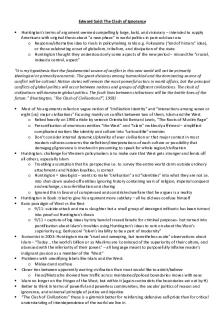Latinos Beyond Reel - Latino representation in cinema due to cultural ignorance of America. PDF

| Title | Latinos Beyond Reel - Latino representation in cinema due to cultural ignorance of America. |
|---|---|
| Author | Jasmine Grimes |
| Course | Culture and Society |
| Institution | University of North Texas |
| Pages | 2 |
| File Size | 41.9 KB |
| File Type | |
| Total Downloads | 81 |
| Total Views | 146 |
Summary
Latino representation in cinema due to cultural ignorance of America. ...
Description
ANTH 2300 Latinos Beyond Reel In the film, Latinos Beyond Reel, the main focal point is the poor representation of how Latinos are depicted in the media, fictional or nonfictional. The displays and stereotypes that the United States media shows about this demographic can be deadly and damaging to the Latino family and individuals. It is apparent that White Americans are not the most culturally tolerant in terms of diversity. Growing up Afro-Latina, I understand wholeheartedly the struggle of being depicted in a negative light in the media. The changes in our society as of 2010s-2020s have grown rapidly, and positively in new entertainment with shows such as On My Block, One Day at a Time, and Gentefied. Despite our stereotypical backgrounds of living in hoods and dealing with gang violence, we are still humans with more creative flexibility than White Americans account us for. The media in terms of news outlets continue to place negative connotations on us, hardly ever highlighting the positive aspects of us, and when the media does, they do not hint at the ethnic background as much as if it were bad news. A problem that the film addresses is the lack representation of Latinos, which do not reciprocate the population percentages in the United States. In the media outlets, “0.6% of stories accounted for are all latinos, while 92% are white”. In America, everyone already knows the opinions of most White Americans, and they are privileged to have more than enough solutions to their responses. Minorities, such as Latinos are not given their opportunity to voice their opinions, their talents, and their ability to be portrayed as humans, not criminals. From the interviews with the children, they did not want to be bad guys, because they do not want to do
bad things, however adults portray those stereotypes to keep that demographic under wraps. Minorities would make art or pitch ideas for books, movies but the main character is always a white person. Since they are all you see in the media, one assumes that stories are only “relatable” stories and will be successful if it is white. Another thing I noticed was the remarkable and successful latinos were white passing and racially ambiguous. They were chosen to appease the Latinos but still must be white enough for the white world, it was to a degree where afro-latinas aren't actually afro-latinas, just a little darker in skin tone but with little to no african ancestry. It ruins the idea that one can not be Black and Latino, and diminishes the racial diversity of Latin America, which for a “melting pot” such as America can not afford to remain ignorant about despite the demographics of the Latino population. Now in the present time, we see a lot of education on what Latinidad truly is, and the ignorance is combatted thanks to the internet. However, the media still continues to keep a strong hold on the narrative of Latinos being invasive and destructive for the United States. It is up to the new generations to continue to fight for the accurate and true representation of their people....
Similar Free PDFs

Said - clash of ignorance
- 1 Pages

Intro to Cinema
- 14 Pages

Two Ways to Belong in America
- 2 Pages

Authorship in Cinema CW2
- 4 Pages

Adjetivos latinos
- 4 Pages

Cinema of Attractions Notes
- 2 Pages

PSQ10 - Democracy in America
- 2 Pages

Rape Culture in America
- 7 Pages

Reel - jkjkkk
- 1 Pages

Latino - Ripasso Latino
- 10 Pages
Popular Institutions
- Tinajero National High School - Annex
- Politeknik Caltex Riau
- Yokohama City University
- SGT University
- University of Al-Qadisiyah
- Divine Word College of Vigan
- Techniek College Rotterdam
- Universidade de Santiago
- Universiti Teknologi MARA Cawangan Johor Kampus Pasir Gudang
- Poltekkes Kemenkes Yogyakarta
- Baguio City National High School
- Colegio san marcos
- preparatoria uno
- Centro de Bachillerato Tecnológico Industrial y de Servicios No. 107
- Dalian Maritime University
- Quang Trung Secondary School
- Colegio Tecnológico en Informática
- Corporación Regional de Educación Superior
- Grupo CEDVA
- Dar Al Uloom University
- Centro de Estudios Preuniversitarios de la Universidad Nacional de Ingeniería
- 上智大学
- Aakash International School, Nuna Majara
- San Felipe Neri Catholic School
- Kang Chiao International School - New Taipei City
- Misamis Occidental National High School
- Institución Educativa Escuela Normal Juan Ladrilleros
- Kolehiyo ng Pantukan
- Batanes State College
- Instituto Continental
- Sekolah Menengah Kejuruan Kesehatan Kaltara (Tarakan)
- Colegio de La Inmaculada Concepcion - Cebu





